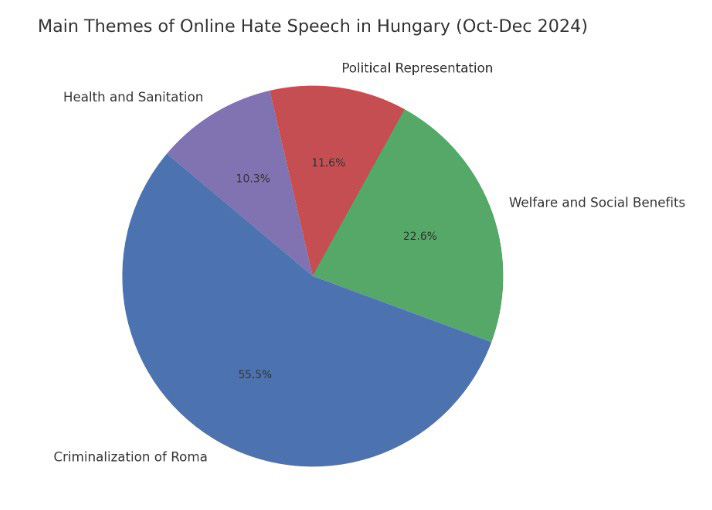A challenging environment for human rights in Hungary
Hungary has faced increasing international criticism for its democratic backsliding and erosion of human rights protections. Roma communities remain among the most marginalised groups, facing systemic discrimination. The European Commission and human rights organisations have repeatedly flagged concerns about racist rhetoric in public discourse and the lack of strong institutional responses to hate speech. This context underscores the urgency of tackling online antigypsyism, a growing problem amplified by digital platforms.

TAAO project: Monitoring online antigypsyism in Hungary
Between October and December 2024, the Romaversitas Foundation monitored 117 cases of antigypsyist hate speech in Hungary’s online space as part of the TAAO project. The study focused on social media platforms, the intensity and themes of hate speech, and the effectiveness of reporting mechanisms.
Social media platforms where hate speech occurs
The report found that antigypsyist content was primarily present on:
- Facebook – 13 cases from personal/private accounts.
- Instagram – 12 cases, including content from online media and influencers.
- YouTube – 6 cases, including posts from public figures.
- TikTok – 13 cases, with a mix of personal accounts and influencers.
- Other online sources – 70 cases, primarily from Hungarian-language websites spreading antigypsyist narratives.
The high presence of antigypsyism on online media outlets (62 cases) highlights how digital news platforms contribute to the spread of racist content.

Main themes of online hate speech in Hungary
The report identified several dominant narratives that fuel antigypsyism in Hungary:
- Criminalisation of Roma: A significant majority (81 cases) framed Roma communities as linked to crime.
- Welfare and social benefits: 33 cases falsely suggested Roma exploit welfare systems.
- Political representation: 17 cases attacked Roma involvement in politics.
- Health and sanitation: 15 cases portrayed Roma as a public health threat.
These narratives, often disguised as “opinion pieces” or “news reports,” contribute to entrenched stereotypes and fuel discrimination both online and offline.
Intensity and forms of hate speech
The level of hostility varied, but many cases included extreme hate speech:
- Crude epithets: 36 cases, with 30 being extremely strong.
- Dehumanising language: 42 cases, often comparing Roma to animals or parasites.
- Mockery and sarcasm: 38 cases, ridiculing Roma culture and identity.
- Appeals to violence: 24 cases, including explicit calls for harm.
Additionally, coded hate speech included:
- Race supremacy rhetoric: 52 cases.
- Pseudo-scientific references: 25 cases (e.g., genetics-based discrimination).
- Irony and ambiguous language: 24 cases.
These forms often avoid explicit racist terminology but reinforce dangerous stereotypes, making moderation more difficult.
The (lack of) response from social media platforms
One of the most striking findings was the lack of platform intervention:
- Only 44 out of 117 cases were reported to social media platforms.
- Instagram and YouTube failed to remove any reported content.
- Facebook removed just one case.
A monitor from the project stated:
“The response from platforms is deeply disappointing. Even content that clearly violates their guidelines stays online. This allows hate speech to thrive and emboldens more people to spread antigypsyist narratives.”
Counter-speech and resistance
Despite the negativity, some users engaged in counter-speech:
- 12 cases involved users challenging racism in discussion.
- 58 cases saw users exposing hate tactics, but few led to removals.
- Only 22 cases were reported to authorities or NGOs.
This reflects a broader lack of trust in institutions to take meaningful action.
Conclusion
The TAAO project’s findings in Hungary confirm that online antigypsyism remains widespread, underreported, and largely unchecked. Criminalisation, welfare myths, and dehumanisation persist without consequences.
To address this issue:
- Social media platforms must enforce their policies and remove antigypsyist content.
- Hungarian authorities must strengthen hate speech laws.
- Public awareness campaigns should educate users and challenge antigypsyist rhetoric.






